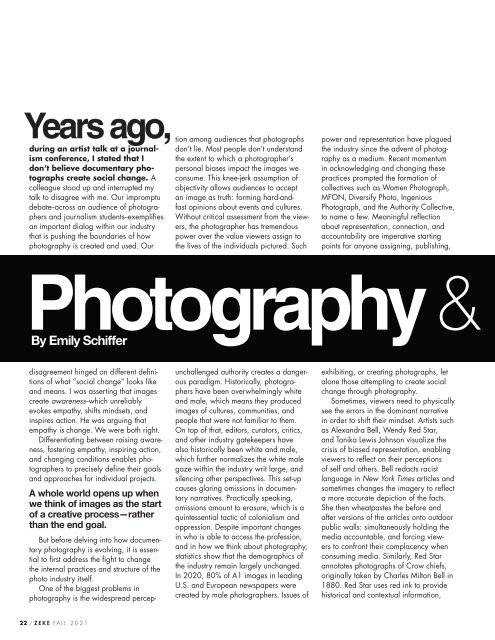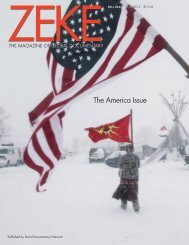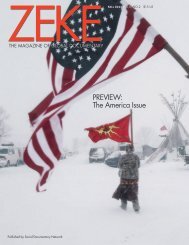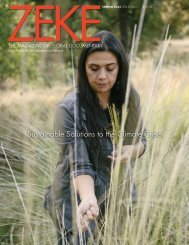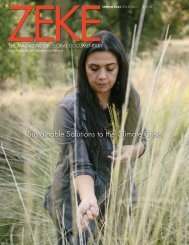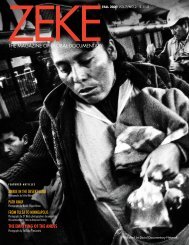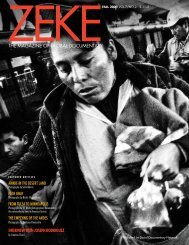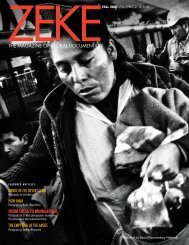ZEKE Magazine: Fall 2021, Preview edition
Subscribe and read full version.
Subscribe and read full version.
Create successful ePaper yourself
Turn your PDF publications into a flip-book with our unique Google optimized e-Paper software.
But before delving into how documentary<br />
photography is evolving, it is essential<br />
to first address the fight to change<br />
the internal practices and structure of the<br />
photo industry itself.<br />
One of the biggest problems in<br />
photography is the widespread percep-<br />
Years ago,<br />
tion among audiences that photographs<br />
during an artist talk at a journalism<br />
conference, I stated that I the extent to which a photographer’s<br />
don’t lie. Most people don’t understand<br />
don’t believe documentary photographs<br />
create social change. A consume. This knee-jerk assumption of<br />
personal biases impact the images we<br />
colleague stood up and interrupted my objectivity allows audiences to accept<br />
talk to disagree with me. Our impromptu an image as truth: forming hard-andfast<br />
opinions about events and cultures.<br />
debate--across an audience of photographers<br />
and journalism students--exemplifies Without critical assessment from the viewers,<br />
the photographer has tremendous<br />
an important dialog within our industry<br />
that is pushing the boundaries of how power over the value viewers assign to<br />
photography is created and used. Our the lives of the individuals pictured. Such<br />
power and representation have plagued<br />
the industry since the advent of photography<br />
as a medium. Recent momentum<br />
in acknowledging and changing these<br />
practices prompted the formation of<br />
collectives such as Women Photograph,<br />
MFON, Diversify Photo, Ingenious<br />
Photograph, and the Authority Collective,<br />
to name a few. Meaningful reflection<br />
about representation, connection, and<br />
accountability are imperative starting<br />
points for anyone assigning, publishing,<br />
Photography &<br />
By Emily Schiffer<br />
disagreement hinged on different definitions<br />
of what “social change” looks like<br />
and means. I was asserting that images<br />
create awareness--which unreliably<br />
evokes empathy, shifts mindsets, and<br />
inspires action. He was arguing that<br />
empathy is change. We were both right.<br />
Differentiating between raising awareness,<br />
fostering empathy, inspiring action,<br />
and changing conditions enables photographers<br />
to precisely define their goals<br />
and approaches for individual projects.<br />
A whole world opens up when<br />
we think of images as the start<br />
of a creative process—rather<br />
than the end goal.<br />
unchallenged authority creates a dangerous<br />
paradigm. Historically, photographers<br />
have been overwhelmingly white<br />
and male, which means they produced<br />
images of cultures, communities, and<br />
people that were not familiar to them.<br />
On top of that, editors, curators, critics,<br />
and other industry gatekeepers have<br />
also historically been white and male,<br />
which further normalizes the white male<br />
gaze within the industry writ large, and<br />
silencing other perspectives. This set-up<br />
causes glaring omissions in documentary<br />
narratives. Practically speaking,<br />
omissions amount to erasure, which is a<br />
quintessential tactic of colonialism and<br />
oppression. Despite important changes<br />
in who is able to access the profession,<br />
and in how we think about photography,<br />
statistics show that the demographics of<br />
the industry remain largely unchanged.<br />
In 2020, 80% of A1 images in leading<br />
U.S. and European newspapers were<br />
created by male photographers. Issues of<br />
exhibiting, or creating photographs, let<br />
alone those attempting to create social<br />
change through photography.<br />
Sometimes, viewers need to physically<br />
see the errors in the dominant narrative<br />
in order to shift their mindset. Artists such<br />
as Alexandra Bell, Wendy Red Star,<br />
and Tonika Lewis Johnson visualize the<br />
crisis of biased representation, enabling<br />
viewers to reflect on their perceptions<br />
of self and others. Bell redacts racist<br />
language in New York Times articles and<br />
sometimes changes the imagery to reflect<br />
a more accurate depiction of the facts.<br />
She then wheatpastes the before and<br />
after versions of the articles onto outdoor<br />
public walls: simultaneously holding the<br />
media accountable, and forcing viewers<br />
to confront their complacency when<br />
consuming media. Similarly, Red Star<br />
annotates photographs of Crow chiefs,<br />
originally taken by Charles Milton Bell in<br />
1880. Red Star uses red ink to provide<br />
historical and contextual information,<br />
22 / <strong>ZEKE</strong> FALL <strong>2021</strong>


